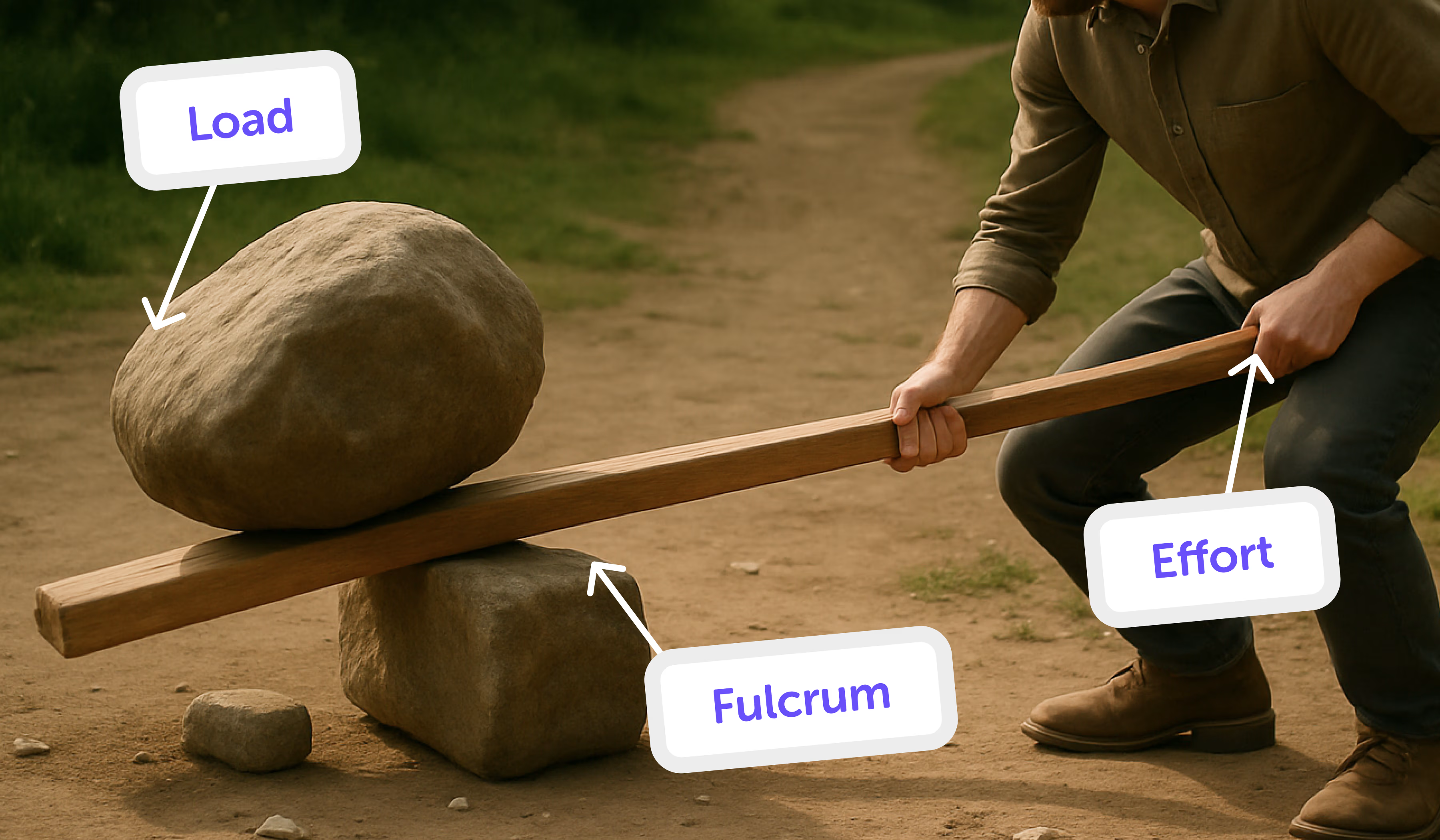A lever is a simple machine that helps you lift, move, or balance objects more easily. It uses a bar and a pivot point (called a fulcrum) to make work simpler. From seesaws to scissors, levers are everywhere! Let’s explore how they work and fun examples kids can test at home.
What Is a Lever?

A lever is one of the six simple machines kids learn about in science. It uses a long bar and a fulcrum (pivot point) to move heavy things with less force. When you push down on one end, the other end lifts showing how levers make work easier.
Think of a seesaw on a playground. When one child pushes down, the other goes up. That’s the power of leverage at work.
Parts of a Lever
Every lever has three parts:
By changing where these parts sit, levers come in three classes and each works a little differently.
How Levers Work - The Science Behind the Strength
Levers work by increasing the distance over which a force is applied. That means you can use a small force to lift something much heavier, depending on where you place the fulcrum. Something you can also discover with our AI homework helper!
The closer the load is to the fulcrum and the farther your effort is from it, the easier the lift.
Here’s a quick breakdown:
Load near the fulcrum = less force needed
Effort far from the fulcrum = more leverage
That’s why a kid can lift something heavy when using the lever correctly!
Types of Levers (Class 1, 2, and 3)
Lever Type | Fulcrum Position | Example | How It Helps |
Class 1 | Between effort and load | Seesaw, Scissors, Pliers | Balances forces |
Class 2 | Between fulcrum and effort | Wheelbarrow, Nutcracker, Bottle opener | Boosts strength |
Class 3 | Between fulcrum and load | Fishing rod, Broom, Tweezers | Increases speed or distance |
Each class of lever is designed for a specific purpose, some give more power, while others offer control or precision.
Need quick hints on fulcrum/effort/load? Open the Homework Helper
Everyday Lever Examples for Kids
Levers aren’t just in science labs they’re all around us!
🪑 Seesaw - classic playground example (Class 1)
✂️ Scissors - use two levers joined at a fulcrum
🧺 Wheelbarrow - Class 2 lever for carrying heavy loads
🧹 Broom - Class 3 lever for sweeping
🥄 Spoon - lever for scooping or flipping food
Each one shows how a small force can move a big object, which is what makes levers such a fun and easy STEM experiment for kids.
Turn examples into practice: test yourself in the Homework Helper
Why Are Levers Important?
Levers make life easier from ancient builders moving stones to kids lifting blocks in class experiments. They teach the idea of mechanical advantage, which means using less effort to do more work.
For young learners, levers show how force, motion, and balance work together key ideas in physics for kids.
Fun Lever Activity for Kids
You can make a lever at home using:
A ruler (bar)
A pencil (fulcrum)
A small toy or coin (load)
Place the ruler on the pencil and press one side. Watch the toy lift! Try moving the pencil closer to one end see how it changes the effort needed?
Not sure why it’s not lifting? Describe your setup and get tips in the Homework Helper
Why Levers Matter - From Playgrounds to Engineering
Levers aren’t just playground fun, they’re everywhere:
Scissors
Crowbars
Wheelbarrows
Shovels
Engineers use the same principles to design cranes, catapults, and even robotic arms. Understanding levers is a first step into the world of engineering and physics.
Common school questions about Levers
What is the definition of a lever?
A lever is a simple machine made of a bar that pivots on a fulcrum to move a load with less effort.
Why do levers make lifting easier?
They let you use a smaller force over a greater distance, which increases your mechanical advantage.
What are real-life examples of levers?
Seesaws, scissors, crowbars, and wheelbarrows are all common examples.
Can kids safely try lever experiments at home?
Yes! With adult supervision and simple materials like rulers and pencils, kids can safely explore how levers work.
What type of lever is a seesaw?
A seesaw is a Class 1 lever, where the fulcrum is in the middle.
What is the best example of a lever?
A seesaw is one of the easiest examples. It shows how a small push on one side can lift something heavy on the other.
What are the 3 types of levers?
Class 1: Fulcrum in the middle (seesaw, scissors)
Class 2: Load in the middle (wheelbarrow, nutcracker)
Class 3: Effort in the middle (broom, fishing rod)
How do levers make work easier?
They reduce the amount of effort needed by spreading force over a longer distance.
What is a lever used for?
Levers help us lift, pry, balance, and move things that would otherwise be too heavy.
Why Levers Matter
Levers are simple but powerful tools that help us do everyday tasks from lifting boxes to playing on seesaws. By learning how fulcrum, effort, and load work together, kids discover the science of simple machines and the idea of mechanical advantage.
And with the DIY.org Homework Helper, they can explore more science projects, ask questions, and practice STEM skills safely at home.
Ready to quiz yourself on levers? Open the Homework Helper. Keep learning simple machines the easy way.




